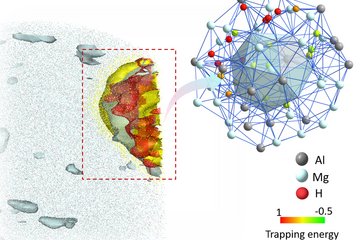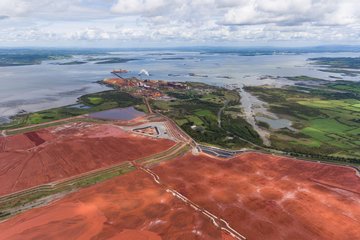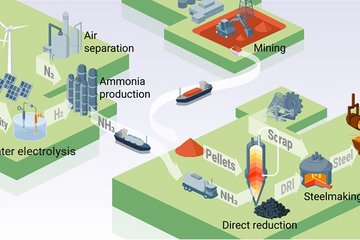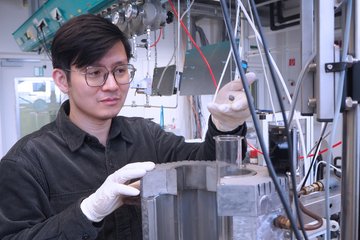Alle Typen
821.
Zeitschriftenartikel
Preferred crystallographic texture of α-chitin as a microscopic and macroscopic design principle of the exoskeleton of the lobster Homarus americanus. Acta Biomaterialia 3, S. 882 - 895 (2007)
822.
Zeitschriftenartikel
Mechanism Oriented Steel Development. Steel Research International 78, S. 195 - 198 (2007)
823.
Zeitschriftenartikel
Equal channel angular extrusion of niobium single crystals. Materials Science and Engineering: A 467, S. 44 - 52 (2007)
824.
Zeitschriftenartikel
Investigation of orientation gradients in pearlite in hypoeutectoid steel by use of orientation imaging microscopy. Steel Research International 78 (1), S. 38 - 44 (2007)
825.
Zeitschriftenartikel
Simulation of earing during deep drawing of an Al-3%Mg alloy (AA 5754) using a texture component crystal plasticity FEM. Journal of Materials Processing Technology 183, S. 169 - 175 (2007)
826.
Zeitschriftenartikel
Roughness-induced flow instability: A Lattice Boltzmann study. Journal of Fluid Mechanics 573, S. 191 - 209 (2007)
827.
Zeitschriftenartikel
Chaotic flows in microchannels: A lattice Boltzmann study. Molecular Simulation 33 (7), S. 583 - 587 (2007)
828.
Zeitschriftenartikel
A texture component model for predicting recrystallization textures. Materials Science Forum 558 / 559, S. 1035 - 1042 (2007)
829.
Zeitschriftenartikel
Modeling and experiments on the indentation deformation and recrystallization of a single‑crystal nickel-base superalloy. Materials Science and Engineering A 454–455, S. 433 - 440 (2007)
830.
Zeitschriftenartikel
Effect of precipitation on rolling texture evolution in continuous cast AA 3105 aluminum alloy. Materials Science and Engineering: A 434 (1-2), S. 105 - 113 (2006)
831.
Zeitschriftenartikel
On strain gradients and size-dependent hardening descriptions in crystal plasticity frameworks. Metals and Materials International 12, 5, S. 407 - 411 (2006)
832.
Zeitschriftenartikel
Overview of Microstructure and Microtexture Development in Grain-oriented Silicon Steel. Journal of Magnetism and Magnetic Materials 304 (2), S. 183 - 186 (2006)
833.
Zeitschriftenartikel
Austenite Grain Coarsening Behavior in a Medium Carbon Si–Cr spring steel with and without Vanadium. Steel Research International 77 (8), S. 590 - 594 (2006)
834.
Zeitschriftenartikel
Evolution of crystallinity and of crystallographic orientation in isotactic polypropylene during rolling and heat treatment. European Polymer Journal 42 (8), S. 1755 - 1766 (2006)
835.
Zeitschriftenartikel
Hardness and elastic properties of dehydrated cuticle from the lobster Homarus americanus obtained by nanoindentation. Journal of Material Research 21 (8), S. 1987 - 1995 (2006)
836.
Zeitschriftenartikel
Self-consistent modeling of large plastic deformation, texture and morphology evolution in semi-crystalline polymers. Journal of the Mechanics and Physics of Solids 54 (7), S. 1350 - 1375 (2006)
837.
Zeitschriftenartikel
Refinement of grain boundary carbides in a Si–Cr spring steel by thermomechanical treatment. Materials Science and Engineering: A 426 (1-2), S. 194 - 201 (2006)
838.
Zeitschriftenartikel
Influence of flow on the global crystallization kinetics of iso-tactic polypropylene. Polymer Testing 25 (4), S. 460 - 469 (2006)
839.
Zeitschriftenartikel
On the consideration of interactions between dislocations and grain boundaries in crystal plasticity finite element modeling – Theory, experiments, and simulations. Acta Materialia 54 (8), S. 2181 - 2194 (2006)
840.
Zeitschriftenartikel
Three dimensional investigation of the texture and microstructure below a nanoindent in a Cu single crystal using 3D EBSD and crystal plasticity finite element simulations. Acta Materialia 54 (7), S. 1707 - 1994 (2006)











